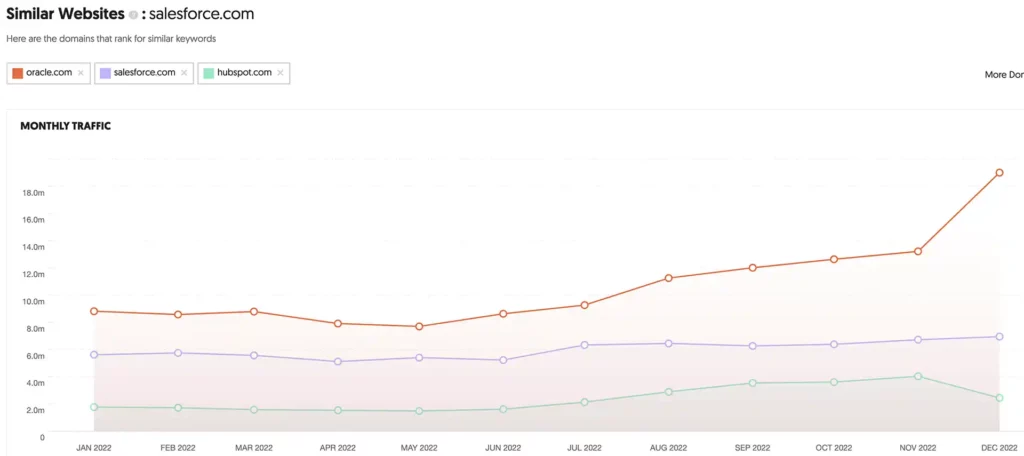How to Use Psychographics in Marketing: A Beginner’s Guide
Learn About How to Use Psychographics in Marketing: A Beginner’s Guide.
Imagine this: An algorithm update hits your business hard, and visibility takes a nosedive. What do you do?
Preferably, you will have already prepared for it in advance.
Listen to this story…
The chief marketing officer of a large, well-known company was devastated when the website analytics came in.
The company had just undergone a major website redesign and rebranding, but the numbers showed that its website traffic had declined by more than 50%.
It quickly became apparent that something was wrong, and the CMO scrambled to find a solution.
He eventually decided to try something new and unfamiliar – psychographics. By understanding their customers better, he hoped he could target the right people with the right message to drive more sales.
Here’s is a website with a quick drop in traffic.

He was on to something big, as it turns out: psychographics has revolutionized modern marketing for both B2C and B2B businesses alike.
Psychographics is a powerful tool for marketers looking to understand customer motivations and preferences. It allows marketers to segment their customers into different groups based on their interests, values, and lifestyles.

By doing so, they can create more effective marketing campaigns tailored to each group’s needs.
Here’s a quick guide to using psychographics in your marketing so that you can take advantage of this powerful tool immediately.
- Identify Your Target Audience: Before using psychographics, it’s important to identify who you are targeting. This should include basic demographic information such as age, gender, location, and income level, as well as more specific psychographic information such as interests and values.
- Conduct Research: Once you have identified your target audience, it’s time to start collecting data about them. This can include surveys, focus groups, interviews, and online research. It would help if you looked for trends and insights into who they are and what they want from your product or service.
- Analyze the Data: After you’ve collected the data, it’s time to analyze it and start creating psychographic profiles for each segment. These profiles should include demographic information, values, beliefs, interests, and lifestyles. By understanding these characteristics of your customers, you can create more targeted and effective campaigns.
- Test Your Campaigns: Once you’ve created the psychographic profiles, it’s time to start testing them in your marketing campaigns. Try different approaches for each segment and measure the results to see which works best for each group.
By using psychographics in your marketing, you can create more targeted and effective campaigns that appeal to the needs of each customer segment. With a better understanding of your customers’ preferences and motivations, you can ensure that your campaigns are as effective as possible.
Here is a competitive profile example for salesforce.com.

Now that you know how to use psychographics in your marketing, it’s time to take advantage of this powerful tool. With the right data and a little bit of creativity, you can create campaigns that get results. Good luck!
This guide has provided an introduction to using psychographics in your marketing. As you become more comfortable with this powerful tool, you’ll be able to take your campaigns even further and achieve even more success. With just a few simple steps, you can start using psychographics to get better results for your business.
What is psychographics?

Psychographics refers to the study and classification of people based on their attitudes, values, interests, and other psychological characteristics.
It is a way of understanding consumer behavior by analyzing their lifestyles, beliefs, opinions, and personalities. Psychographics is often used in market research, advertising, and political campaigns to target specific groups of people with tailored messages and products that appeal to their unique psychographic profiles.
Some factors that can be analyzed through psychographics include personality traits, values, beliefs, interests, hobbies, lifestyle, opinions, and attitudes toward certain topics or issues.
Psychographic data is usually collected through surveys, interviews, and other forms of research to help businesses and organizations create more effective marketing campaigns and improve their products and services to meet the needs of their target audience better.
What are the psychographics, and how are they used in marketing
Are you looking to take your marketing campaigns to the next level? Are you curious about psychographics and how they can be used in marketing? If so, you’re in luck – this blog post will cover all aspects of psychographics and how these powerful tools can help marketers reach their desired audience more effectively.
To understand how psychographics works within a marketing context, it is important to understand what they are and why they are valuable.
In this post, we will look at the definition of psychographics and its application in successful marketing campaigns. We will also discuss the various data points that fall under the category of psychographic profiling that allow us to create targeted advertising strategies more efficiently.
Understanding how to leverage such information allows us to make better decisions when creating digital media plans for reaching particular demographic segments with tailored messaging that resonates. So let’s unpack what makes up this critical tool from a strategic perspective!
Defining Psychographics – What Are They and How Are They Used in Marketing

In marketing, knowing your target audience is crucial. Understanding their behaviors, interests, and values can help you create more effective campaigns that resonate with them on a deeper level. And that’s where psychographics comes in. Psychographics refers to the study of consumer personality, values, attitudes, and lifestyle.
By collecting and analyzing this data, businesses can gain insights into what motivates their customers to make purchasing decisions and use that information to tailor their messaging and offerings accordingly. It’s a powerful tool that can help businesses connect with their customers more emotionally and ultimately drive better results.
Identifying Your Target Audience Through Psychographic Segmentation
When it comes to marketing, identifying your target audience is crucial for success. Psychographic segmentation is a method that can help you achieve this by considering the interests, values, lifestyles, and personality traits of your potential customers.
By diving deeper into your audience’s psychological and behavioral aspects, you can tailor your marketing strategies to their preferences and needs.
This can lead to higher customer satisfaction and loyalty and an increased likelihood of conversions. In a world of fierce competition, psychographic segmentation can give you a significant edge by helping you connect with your audience on a more personal level.
Analyzing Your Audience by Demographic and Psychographic Factors
Understanding your audience is crucial for delivering a message that resonates with them. One way to analyze your audience is through demographic and psychographic factors.
Demographic factors include age, gender, income, education level, etc. Psychographic factors, on the other hand, consider personality traits, values, interests, and lifestyles. You can better understand your audience’s needs, preferences, and behavior by analyzing these factors.
This allows you to tailor your message to be more impactful and effective. It also helps to ensure that you connect with your audience more personally, ultimately leading to a stronger relationship with them.
So the next time you’re preparing to deliver a message, take the time to analyze your audience through demographic and psychographic factors.
Developing an Effective Psychographic Profile of Your Audience
When it comes to an understanding your audience, creating an effective psychographic profile is key. By diving deep into your target market’s motivations, behaviors, and attitudes, you can gain invaluable insights into what makes them tick.
But where do you start? One helpful tool is to create buyer personas, or fictional representations of your typical customers, which can help you identify common traits and pain points that will inform your messaging and marketing efforts.
As you develop your psychographic profile, it’s also important to consider external factors, such as cultural trends, economic conditions, and other contextual factors that may impact consumer behavior.
By staying attuned to the needs and preferences of your audience, you’ll be well on your way to building a loyal customer base and driving business success.
Utilizing Psychographics to Personalize Messaging and Offerings
Personalization is key to standing out in a world where consumers are constantly bombarded with marketing messages. Psychographics provide a valuable tool for achieving this personalization.
By understanding their target audience’s values, personalities, and lifestyles, businesses can craft messaging and offerings that resonate with them more deeply. This can lead to stronger customer relationships, increased loyalty, and more sales. Utilizing psychographics shows that businesses are not just trying to sell a product but truly understand and care about their customers.
As technology evolves, gathering and analyzing this data type is becoming easier than ever, making it a valuable asset for any savvy marketer.
Integrating Psychology Into Advertising Strategies with Psychographics
Effective advertising strategies have always relied on understanding the target audience. However, with the advent of psychographics, advertisers can now delve deeper into a consumer’s mindset and personality and use this information to create more personalized and engaging ad campaigns.
By integrating psychology into advertising strategies, marketers can better identify what their audience wants, needs, and aspires to. This can lead to more effective advertising campaigns that speak directly to the consumer, resonating with them deeper.
With psychographics, advertisers can move beyond basic demographics and tailor their messaging to individual customers’ unique personality traits and motivations. The result? More engaged and loyal consumers are likelier to identify with and purchase from a brand.
How to Use Psychographics in Marketing

Understanding your target audience’s needs, preferences, and buying habits is crucial in marketing. One effective way to do this is by utilizing psychographics.
Psychographics studies consumer behavior, including personality traits, values, interests, and lifestyles. By understanding these factors, marketers can create content and promotions that resonate with their audience on a deeper level, leading to increased engagement and sales.
To effectively use psychographics in marketing, it’s important to conduct thorough research, segment your audience based on common psychographic traits, and tailor your messaging to each group.
By doing so, you can create marketing campaigns that truly resonate with your audience, resulting in long-term success for your brand.
Show How 4 Brands Have Improved Results Using Psychographics
Psychographics, the study of consumers’ attitudes and values, has become an important tool for brands looking to improve their results.
Four brands, in particular, have successfully utilized psychographics to enhance their marketing strategies.
- Outdoor retailer Patagonia has leveraged its customers’ shared environmental and social responsibility values to drive engagement and sales.
- Fast-food McDonald’s has used psychographics to tailor its menu to customers’ changing tastes and preferences.
- Luxury fashion house Burberry has leveraged social media monitoring tools better to understand its customers’ evolving lifestyles and preferences.
- Coca-Cola has used psychographics to identify the emotional triggers that drive consumer purchasing decisions, resulting in highly effective advertising campaigns.
By incorporating psychographics into their marketing strategies, these brands have achieved notable success in today’s highly competitive marketplace.
Online advertising campaign conversion Increased with Psychographics.
In online advertising, finding the right target audience is essential to the success of any campaign. And while demographics have long been the go-to for targeting, the rise of psychographics has proven to be a game-changer.
Advertisers can craft messages that truly resonate and drive conversions by tapping into potential customers’ psychology, beliefs, values, and interests. As an expert in online advertising,
I’ve seen firsthand how using psychographics has helped my clients achieve remarkable results, with increased click-through rates, conversions, and higher ROI. The numbers don’t lie – if you want to take your online advertising campaign to the next level, it’s time to start thinking beyond demographics and embrace the power of psychographics.
Conclusion on Psychographics in Marketing
Understanding psychographics in marketing can hugely benefit any business or organization. The importance of psychographics in marketing goes without saying.
Understanding the psychology behind consumer behaviors can not only help you to identify your target audience, but it can also help you personalize messaging, hone advertising strategies, and offer highly targeted offerings.
Brands have noticed large increases in conversions by focusing on more personalized messaging driven by psychographic data. If you want to increase the effectiveness of campaigns, conversions, and sales, consider investing in resources that provide insights into consumer motivation through their psychographic profile.
We’ll talk about:
- Why are psychographics important in marketing
- What are psychographics in marketing
- What is psychographics in marketing
- Examples of psychographics in marketing.
With some effort and analytics investments, you can understand your customer’s needs deeper and offer them something they’ll appreciate. So take advantage of this powerful tool today – grab the sales tool now to boost conversions and sales!
General FAQs on Psychographics in Marketing
What is psychographics, and how can it be used in marketing?

Psychographics studies consumers’ attitudes, values, interests, and lifestyle choices. It is a powerful tool for marketers to gain insights into their target audience’s motivations and behaviors. Using data collected from psychographic research, marketers can create more effective campaigns tailored to their customers’ needs and interests, increasing engagement and sales.
How can I use psychographics to segment my audience?

To effectively use psychographics in marketing, it’s important to conduct thorough research on your target audience and segment them based on common psychographic traits such as age, gender, income level, education level, occupation, and lifestyle choices. Once you have identified common characteristics among your customer segments, you can craft messages that are tailored toward each group to ensure they truly resonate with your audience.
What techniques can I use to leverage psychographics?

There are several techniques that marketers can use to leverage psychographics in their campaigns, including social media monitoring tools and surveys/interviewing customers directly about their preferences or motivations behind certain purchases. Additionally, you can use analytics tools such as Google Analytics or Adobe Analytics to track customer behavior patterns over time so that you can better understand what motivates them when making decisions about products or services offered by your brand.
How has leveraging psychographics helped other brands?

Companies across all industries have seen success utilizing psychographic data in their campaigns – from fast-food chain McDonald’s leveraging customer tastes and preferences for menu items; outdoor retailer Patagonia utilizing its customers’ shared values of environmental responsibility; luxury fashion house Burberry leveraging social media monitoring tools; to Coca-Cola identifying emotional triggers driving consumer purchasing decisions – all have achieved notable success due to incorporating this powerful tool into their strategies.

